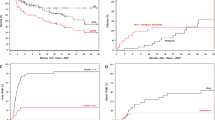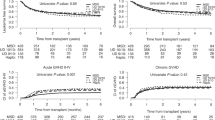Abstract
The utility of bone marrow transplantation for childhood leukemia in patients unable to achieve a remission prior to transplant is controversial. To address this issue, we analyzed a subset of patients with advanced leukemia entered on prospective transplant trials at our hospital. Fifty-eight patients with ALL or AML (age 1–19) were identified. They had failed standard chemotherapy and were in relapse (22 in 1st, 27 in 2nd, three in 3rd, and three in 4th) or had never achieved an initial remission (three) at the time of transplant. Fifty-two patients received marrow from mismatched family members (haplo or DR-identical), while six received marrow from matched siblings. Most patients received myeloablative therapy consisting of total body irradiation, etoposide, cyclophosphamide, and cytosine arabinoside. Marrow from mismatched donors was T cell depleted. Only one of 52 patients transplanted with a mismatched donor survived long-term while three of six patients transplanted in relapse with a fully matched sibling donor are alive 6–10 years post BMT. The major causes of death were infection (39%) and relapse (28%). Acute GVHD grade III–IV was noted in 7% of patients. A comparable group of patients with leukemia transplanted at our center in remission using similarly mismatched family member donors (haplo or DR-identical) had an event-free survival of 28%. In conclusion, our data suggest that BMT utilizing mismatched family member donors is a poor option for patients in relapse at the time of transplant. New treatment strategies need to be developed to effectively manage these patients. Bone Marrow Transplantation (2000) 25, 943–948.
This is a preview of subscription content, access via your institution
Access options
Subscribe to this journal
Receive 12 print issues and online access
$259.00 per year
only $21.58 per issue
Buy this article
- Purchase on Springer Link
- Instant access to full article PDF
Prices may be subject to local taxes which are calculated during checkout



Similar content being viewed by others
References
Reaman G, Zeltzer P, Bleyer W et al. Acute lymphoblastic leukemia in infants less than one year of age: a cumulative experience of the Children’s Cancer Study Group J Clin Oncol 1985 3: 1513–1521
Steinherz P, Gaynon P, Breneman J et al. Cytoreduction and prognosis in acute lymphoblastic leukemia – the importance of early marrow response: report from the Children’s Cancer Group J Clin Oncol 1996 14: 389–398
Bloomfield C, Secker-Walker L, Goldman A et al. Six-year follow-up of the clinical significance of karyotype in acute lymphoblastic leukemia Cancer Genet Cytogenet 1989 40: 171–185
Goldman FD, Trigg ME . Bone marrow transplantation for relapsed acute lymphoblastic leukemia Int J Pediatr Hematol Oncol 1998 5: 215–230
Dopfer R, Henze G, Bender-Gotze C et al. Allogeneic bone marrow transplantation for childhood acute lymphoblastic leukemia in second remission after intensive primary and relapsed therapy according to the BFM and CoALL protocol: Results of the German Cooperative Study Blood 1991 78: 2780–2784
Chessells JM, Bailey C, Wheeler K et al. Bone marrow transplantation for high-risk childhood lymphoblastic leukemia in first remission: experience and MRC UKALL X Lancet 1992 340: 565–568
Michel G, Gluckman E, Blaise D et al. Improvement in outcome for children receiving allogeneic bone marrow transplantation in first remission of acute myeloid leukemia: a report from the Groupe D’etude Des Greffes De MoelleOsseuse J Clin Oncol 1992 10: 1865–1869
deAlarcon PA, Trigg ME, Giller RH et al. Bone marrow transplantation improves survival for acute lymphoblastic leukemia in relapse: a preliminary report Am J Pediatr Hematol/Oncol 1990 12: 468–471
Fleming DR, Henslee-Downey PJ, Romond EH et al. Allogeneic bone marrow transplantation with T-cell depleted partially matched related donors for advanced acute lymphoblastic leukemia in children and adults: a comparative matched cohort study Bone Marrow Transplant 1996 17: 917–922
Trigg ME . Bone marrow transplantation using alternative donors Am J Pediatr/Hematol Oncol 1993 15: 141–149
Trigg ME, Peterson A, Bozdech M et al. Depletion of T-cells from bone marrow for allogeneic transplantation: method for treatment of bone marrow in bulk Exp Hematol 1986 14: 21–26
Martin PJ, Hansen JA . Quantitative assays for detection of residual T-cells of T-depleted human marrow Blood 1985 65: 1134–1140
Kaplan EL, Meier P . Nonparametric estimation from incomplete observations J Am Stat Assoc 1958 53: 457–481
Balduzzi A, Cooley T, Anasetti C et al. Unrelated donor marrow transplantation in children Blood 1995 86: 3247–3256
Casper J, Camitta B, Truitt R et al. Unrelated bone marrow donor transplants for children with leukemia or myelodysplasia Blood 1995 85: 2354–2363
Davies SM, Wagner JE, Xiao-Ou S et al. Unrelated donor bone marrow transplantation for children with acute leukemia J Clin Oncol 1997 15: 557–565
Butturini A, Gale RP . T-cell depletion in bone marrow transplantation for leukemia current results and future directions Bone Marrow Transplant 1988 3: 185–192
Anasetti C, Amos D, Beatty P et al. Effect of HLA-compatibility on engraftment of bone marrow transplants in patients with leukemia or lymphoma New Engl J Med 1989 320: 197–204
Skinner J, Finlay J, Sondel P, Trigg M . Infectious complications in pediatric patients undergoing transplantation with T-lymphocyte-depleted bone marrow Pediatr Infect Dis J 1986 5: 319–324
Trigg ME, Morgan D, Burns TL et al. Successful program to prevent aspergillus infections in children undergoing marrow transplantation: use of nasal amphotericin Bone Marrow Transplant 1997 19: 43–47
Montagna D, Locatelli F, Calcaterra V et al. Does the emergence and persistence of donor-derived leukemia-reactive cytotoxic T-lymphocytes protect patients given an allogeneic BMT from recurrence? Results of a preliminary study Bone Marrow Transplant 1998 22: 743–750
Dazzi F, Goldman JM . Adoptive immunotherapy following allogeneic bone marrow transplantation Ann Rev Med 1998 49: 329–340
Lee C-K, Gingrich RD, deMagalhaes-Silverman M et al. Prophylactic reinfusion of T cells for T-cell-depleted allogeneic bone marrow transplantation Biol Blood MarrowTransplant 1999 5: 15–27
Acknowledgements
We thank the dedicated nurses of the Pediatric Bone Marrow Transplantation Unit. Special thanks to Erin Gleusing and Stephane Diamantis for data management and Marsha Gerot for preparation of this manuscript.
Author information
Authors and Affiliations
Rights and permissions
About this article
Cite this article
Goldman, F., Rumelhart, S., DeAlacron, P. et al. Poor outcome in children with refractory/relapsed leukemia undergoing bone marrow transplantation with mismatched family member donors. Bone Marrow Transplant 25, 943–948 (2000). https://doi.org/10.1038/sj.bmt.1702373
Received:
Accepted:
Published:
Issue Date:
DOI: https://doi.org/10.1038/sj.bmt.1702373
Keywords
This article is cited by
-
Comparison of clinical outcomes between peripheral blood stem cells and peripheral blood stem cells plus bone marrow in myelodysplastic syndrome patients with haploidentical transplantation
Bone Marrow Transplantation (2023)
-
Outcome of hematopoietic stem cell transplantation in pediatric patients with acute lymphoblastic leukemia not in remission enrolled in JACLS ALL-02
International Journal of Hematology (2023)
-
Pre-conditioning intervention in patients with relapsed or refractory acute lymphoblastic leukemia who underwent allogeneic hematopoietic cell transplantation: a KSGCT multicenter retrospective analysis
Annals of Hematology (2021)
-
Prognostic index for patients with relapsed or refractory acute myeloid leukemia who underwent hematopoietic cell transplantation: a KSGCT multicenter analysis
Leukemia (2019)
-
Hematopoietic stem-cell transplantation in children with refractory acute myeloid leukemia
Bone Marrow Transplantation (2019)



